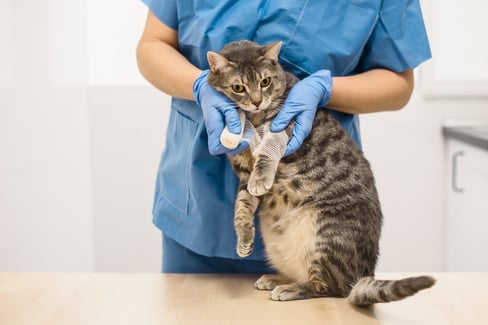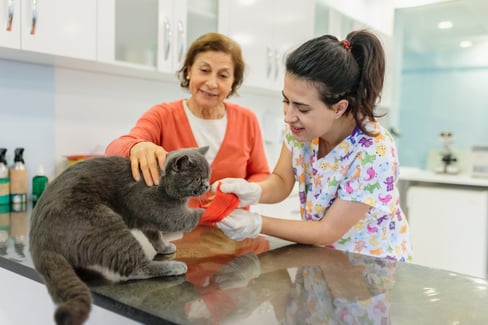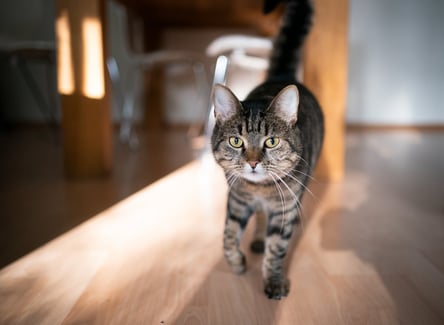Most cat owners will joke about the cat distribution system, where a cat will find you and decide it now lives with you, rather than you going out and adopting a cat of your own free will. Turns out, there’s some truth to this funny meme.
At some point thousands of years ago, cats started wandering into human settlements and hanging out, providing pest control and companionship. Considered an extreme outlier to typical domestic animals. Unlike dogs, whose temperaments and bodies have transformed radically over the years thanks to human intervention, cats remain largely the same as their wild counterparts in genetics and physical characteristics.
Because that wild side never really left our beloved house cats, they can get into all sorts of trouble, from getting stuck in trees to getting into encounters with other animals. Cat paw injuries are common because cats love to jump, play, and pounce. When left untreated, a simple cat paw injury can quickly develop into a cat paw infection.
And infections are no joke—not only are cat paw infections painful for your cat, but they can also spread and lead to serious secondary issues, including problems with their eyes and skin, fever, weight loss, difficulty breathing, and more.
In this article, we explore the signs that your cat’s paw could be infected, potential causes of cat paw infection, treatment options, and preventative measures that you can take.
How to Spot Signs of Cat Paw Infection
If your cat is suffering from a cat paw infection, there will be physical and behavioural signs that your cat will likely exhibit. Some cats may not act differently when they have a cat paw infection, while others may become more aggressive and irritable. At the end of the day, you know your cat best, so if there are alarming differences in their appearance or behaviour, it’s time for a trip to the vet.
Physical Signs of Cat Paw Infection
A cat paw infection will often present physical signs that should be relatively easy for you to spot. These physical signs include:
- Red, swollen skin on the infected area. When a cat paw is infected, the skin will appear swollen and red compared to a healthy paw. Typically you should be able to see this on the paw pads. If your cat has darker or blotchy skin, which is common with tortoiseshell and calico cats, it may be more difficult to spot reddish-coloured skin, but if you can compare the size of the potentially swollen cat paw with a healthy one, you should be able to see the difference.
- Blood, pus, or crusty material on the skin. When your cat’s body is trying to fight an infection, it will send white blood cells to the area to isolate and destroy the infection, which causes swelling, and if the area is an open wound, it will present as pus or crusty material as the pus dries. You may also notice fresh or dried blood on the area.
- Yellow, green, or white discharge. Pus from an open wound or broken skin on your kitty’s body will typically appear white. This is because of the white blood cells your kitty’s body sends to the area to fight the infection. However, as surrounding tissue decays and mixes with inflammatory cells over time, the pus may also present as a yellow or green discharge.
- Foul odor. If bacteria and foreign material mix with the cat paw infection, you may notice an unpleasant smell coming from the area. This is due to the decayed tissue and pus, a sign that the infection has likely been there for a while.
- Matted and/or missing fur. A cat paw infection is uncomfortable for your furry friend, so they’ll likely be licking the area in an attempt to soothe it. Because cat tongues have papillae, which are little barbs consisting of keratin—the same stuff human nails are made of, it’s easy for them to irritate the area even more. The result of excessive licking can be matted fur that gets crusty and flat as it is mixed with the blood and pus from the infection and dries, or missing patches of fur that leave behind red, swollen, and raw patches of skin.
Behavioural Signs of Cat Paw Infection
Sometimes, your cat may not have physical signs of a cat paw infection that are easy to spot or may exhibit behavioural signs that they are uncomfortable and in pain in addition to the physical signs of infection. These behavioural signs of infection include:
- Sudden aggressiveness and irritability. While sometimes our kitties can be grouchy for seemingly no reason, if your normally chill kitty suddenly hisses, bites, or scratches you, it could be a sign that they are a cat in pain. Your cat may react this way because it hurts more if the infected area is touched in any way or simply out of fear.
- Excessive licking and grooming. If you notice your cat hyper-focusing on their paw while grooming or licking the area excessively, it could be a sign that they are suffering from an infected paw. Your cat will instinctively lick a sore or infected area to clean it and help it feel better, but this often worsens the infection. Your vet will likely recommend placing a cone or e-collar on your cat to prevent them from irritating the area while it heals.
- Limping and avoiding putting pressure on the affected paw. If your foot was swollen and infected, you probably wouldn’t want to move around much. The same goes for your cat. A painful paw will likely result in them either limping when they walk (which could be a sign that there is a break somewhere in their foot or leg) or avoiding putting pressure on the paw altogether. Watch your kitty while they walk and look for signs that they are favouring a specific paw if you’re concerned about potential infection. It’s important to remember that a cat with diabetes may exhibit a plantigrade stance, which is when the disease affects the nerves in your cat’s hind legs, resulting in limping. While it’s a rarer symptom of diabetes in cats, it could also explain limping. If your cat is limping because of the plantigrade stance, it typically won’t be in pain, so it will lack other signs of a cat paw infection (which is always painful for your kitty).
- Lack of appetite. If your kitty is dealing with a serious infection, it may not feel like eating. A kitty that doesn’t want to eat is a serious secondary symptom that needs to be treated by a veterinarian as soon as possible. A cat that isn’t eating or drinking can develop conditions like liver and kidney failure in just a few days.
Causes of Cat Paw Infection
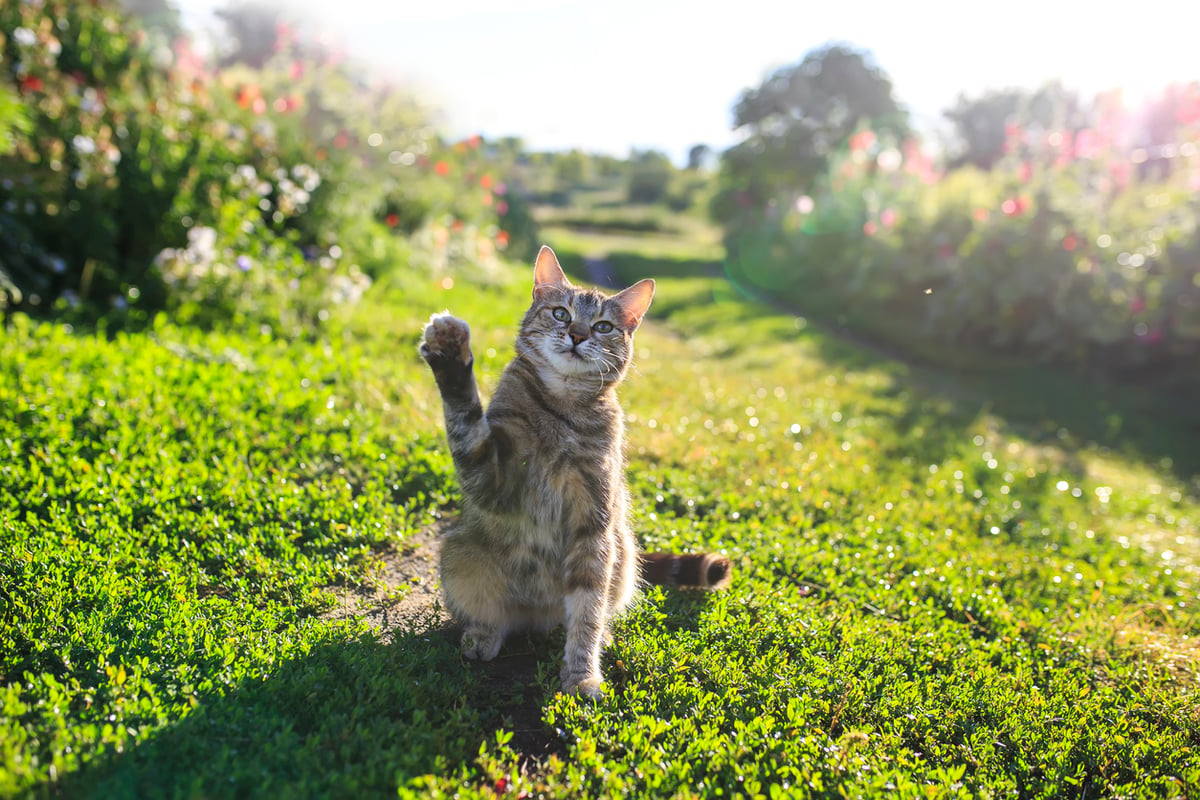
Considering their daredevil nature, cats can get themselves into endless different tricky situations that can result in a cat paw infection. However, in some cases, an infection can spread from a different area of your kitty’s body to one or more paws.
Some potential causes of cat paw infection include:
1. Joint Injuries
The majority of cats have 18 joints in their feet: 5 digits on each foot, including the dewclaw, and 4 on each hind foot. Some cats have even more joints if they are polydactyl, meaning “many fingers or toes”. Because cats have so many joints in their feet, it’s easy to see how a foot joint injury could result in a cat paw infection. Inflammation in joints could spread to the paw, resulting in swollen and red skin. In many cases, veterinarians prescribe ointment, NSAIDs, or joint supplements to treat the injury.
NSAIDs are painkillers, kind of like human ibuprofen. Unfortunately, prolonged use of NSAIDs can result in nasty side effects for your kitty, including kidney and liver problems. NSAIDs are usually only prescribed briefly because of the risk of negative side effects. However, if your kitty has chronic joint pain, there is another solution that can help them get off the NSAIDs faster: joint supplements.
Joint supplements have therapeutic value and will help your kitty heal from a joint injury and help prevent future injuries by strengthening their joints. Cat supplements for joint health should include glucosamine, chondroitin, Methylsulfonylmethane (MSM), and hyaluronic acid. These ingredients and their benefits are described in more detail in the following table:
|
Joint Supplement Ingredient
|
Benefit
|
|
Glucosamine HCl and Sulfate
|
- Glucosamine sulfate includes sulfur, which is an essential ingredient to support the repair of and prevent degradation of your cat’s joint structures.
- Glucosamine HCl is a highly bioavailable form of glucosamine, meaning that your cat’s body will absorb it quickly and be able to benefit from its positive joint effects faster (lubrication, cartilage repair, etc.)
|
|
Chondroitin
|
- When combined with glucosamine, chondroitin helps repair cartilage and prevent degradation of the cartilage, which is essential for pain-free and easy movement.
|
|
MSM
|
- As a natural anti-inflammatory, MSM reduces swelling and redness of inflamed and painful joints.
|
|
Hyaluronic Acid
|
- Increased the viscosity of the synovial fluid in your cat’s joints, helping them move easier and reducing friction in the joint structures.
|
Another consideration when choosing joint supplements for your cat is the amount of active ingredients versus inactive ingredients. Most joint supplements will list how much of each ingredient in the table above is in each dose. So if the dose is 1g (1000mg), and the number of active ingredients only adds up to 500mg, you know that half the dose is inactive ingredients—stuff your kitty doesn’t need!
TRI-ACTA products are made with 100% active ingredients, so each dose is providing your kitty with the maximum therapeutic value. If your kitty has chronic joint issues and needs extra protection, TRI-ACTA H.A. is the best option, as it includes hyaluronic acid for additional joint support.
2. Broken Bones
There are a lot of bones in your cat’s feet—which means a lot of potential for them to break something during a particularly daredevil feat. A tiny broken bone in a cat’s paw can be difficult to spot unless it’s affecting your cat’s behaviour or movement. Untreated broken bones in the paw can result in a cat paw infection as your cat’s body tries to heal the bone.
Usually, larger broken cat bones can be set with a splint, but more complex breaks and breaks with smaller bones may need surgery to repair. Surgery to repair a broken bone usually involves screws, pins, or even plates to hold the bone in the proper place as it heals. During this time, your vet may prescribe NSAIDs to provide your kitty with some pain relief and possibly antibiotics to help treat any current infection.
3. An Infection That’s Spread From Another Area
Sometimes infections can spread quickly, affecting another area of your cat’s body in addition to the source of the infection. For example, if your cat has a broken bone in their leg, the redness and swelling may expand to include your cat’s paw as well. Broken and infected skin on your cat’s leg can also result in redness and swelling traveling to the paw and paw pad.
It’s important to seek veterinary care for your kitty if they have signs of infection since they may require antibiotics and pain relief.
3. Foreign Material Stuck in the Paw
Cats are naturally curious and love to explore, which can sometimes result in them getting into sticky situations. While many cats love to hang out in the great outdoors, their soft paw pads are vulnerable to thorns, slivers, and other things in the environment.
If a thorn, sliver of wood, or other foreign material gets stuck in your cat’s paw, their body will immediately try to isolate it from the surrounding tissues. During this process, your cat’s paw may become infected if the material isn’t removed in a timely manner.
In most cases, removing the foreign material and treating any remaining open wound is enough to give your cat the relief they need.
4. Cat Paw Yeast Infection
The black and dark brown stuff that can sometimes accumulate on your cat’s paws is called yeast. Specifically, a type of yeast called Malassezia naturally appears on the skin of cats and dogs. In cats, this yeast will often appear in the ears and paws. When the amount of yeast gets out of control, usually due to an allergic reaction or internal issue with your cat’s hormones, it can cause an infection. When too much malessezia accumulates on your cat’s paws, it results in red, itchy, and swollen skin, characteristic of a cat paw yeast infection.
Because a cat paw yeast infection is very itchy and uncomfortable for your kitty, they will likely lick the area continuously in an attempt to soothe it. Unfortunately, repeated licking often worsens the infection, making the skin more raw, red, and inflamed. Your vet can provide medicated ointment to relieve the infection's symptoms, but the underlying cause should also be investigated. Food allergies, hypothyroidism, and hyperadrenocorticism (Cushing’s disease) are several possible causes of cat yeast infections.
Cat Paw Infection Treatment Options
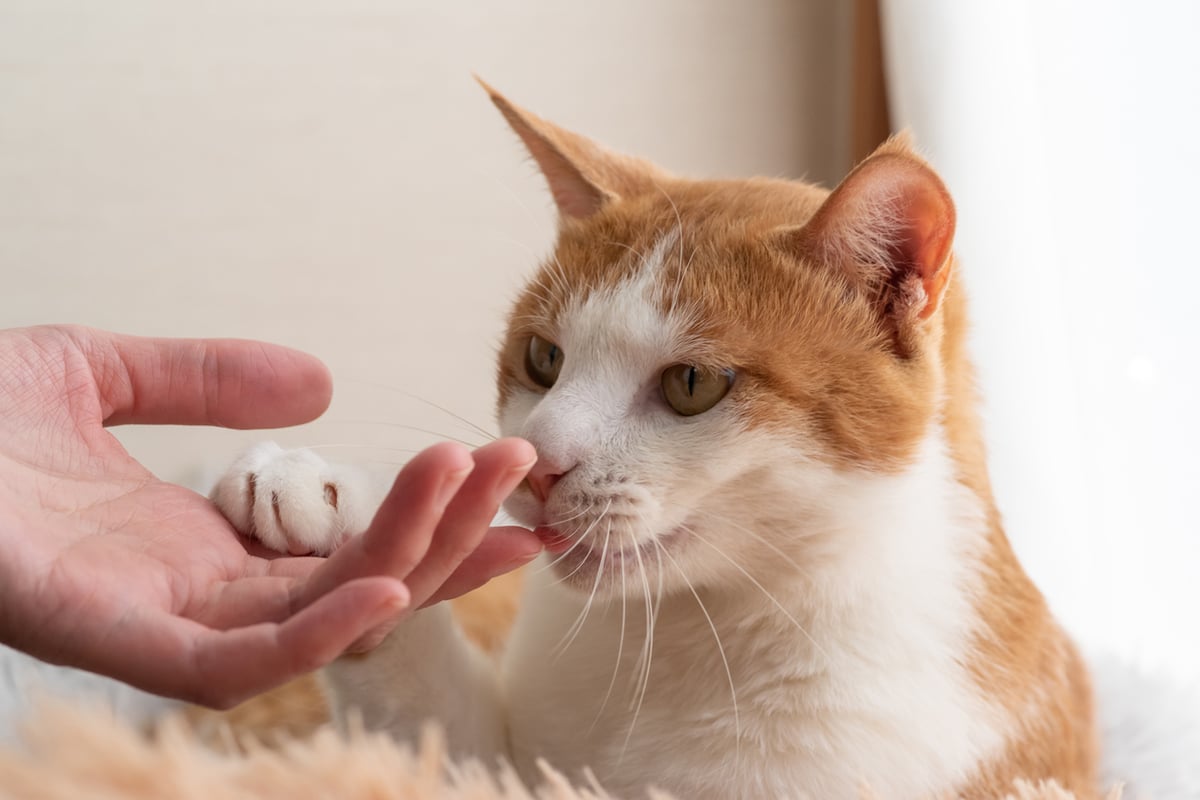
Depending on the type of cat paw infection, various treatment options are available to help your cat feel more comfortable and heal. First, let’s look at some treatments that your vet will likely recommend:
1. NSAIDs & Inflammation Treatments
A cat paw infection can be a painful experience for your kitty, so to help relieve the pain, your vet may prescribe NSAIDs as a cat paw infection treatment. As we mentioned earlier in this article, prolonged use of NSAIDs can have serious adverse side effects for your kitty, including developing kidney and liver issues, so their use should ideally be short-term only.
A cat paw pad infection or cat paw infection usually only needs short-term treatment anyway, so giving NSAIDs for pain relief in these cases isn’t generally a risk unless your cat is already experiencing reduced kidney function or liver problems. Your vet will assess your cat and likely perform a blood test if they are concerned about these issues being exacerbated by NSAIDs.
One of the ways you can help your kitty’s inflammation and protect the delicate joint structures in their paws is by using joint supplements with MSM, like TRI-ACTA. By giving your kitty joint supplements, you can reduce the dosage of NSAIDs necessary for joint pain relief over time, and eventually not have to give NSAIDs at all.
2. Antibiotic Ointment
Your vet may also prescribe antibiotic ointment to treat a cat paw pad infection that is accompanied by open sores or broken skin. The ointment helps soothe itchy, red, and swollen skin while at the same time helping the area heal faster and help protect the area from becoming more infected and the infection from spreading.
3. Cat Paw Infection Home Remedy
While taking your cat to the vet is the best option if you suspect that they have a cat paw infection, there are certain things you can do at home to provide care for your cat’s infection until you can see your vet.
If your cat has broken or torn skin on their paw pad, here are some steps that you can take to treat it:
- Clean the wound. Look for foreign material in and around your kitty’s paw pad, such as glass, thorns, or dirt, and remove them the best you can. Dirt and other loose material can be washed away with clean water, while larger debris may require a pair of tweezers to remove. If there is deep-seated debris in your cat’s paw pad, it’s best to wait until a veterinarian can remove it, as digging around in the wound may result in it getting worse.
- To control bleeding, apply pressure to the wound. Applying pressure with a clean towel for a few minutes will help stop the bleeding for minor wounds, but deeper wounds may take longer. If you can’t control the bleeding with pressure after 10-15 minutes, you must get your cat to the vet as soon as possible.
- Protect the wound by applying a bandage. To prevent more debris and dirt from getting into the wound and to protect it from further damage, apply a bandage to your cat’s paw pad. Using gauze pads and a self-sticking bandage wrap is the best way to keep the gauze secure.
- Change the bandage daily. Be sure to change the bandage on a regular basis, ideally daily, as the gauze will absorb blood and pus from the wound. If your kitty’s toes appear swollen or you notice a foul odor, immediately take them to a vet. These signs could indicate compromised circulation in the paw, which could result in permanent damage if not treated properly.
If your cat has a cat paw yeast infection, there are several ways you can treat the condition at home. Remember that if the condition doesn’t improve or appears to worsen, you should take your cat to the vet for treatment.
The table below highlights some ways you can treat a yeast infection cat paw:
|
Home remedy for cat paw yeast infection
|
Instructions
|
Considerations
|
|
Vinegar and water solution
|
Mix 1 part vinegar with 5 parts water
|
Provides a mild anti-yeast effect, may not be effective against more advanced infections
|
|
Clotrimazole (athlete’s foot cream or spray)
|
Spray or rub directly on the affected area daily
|
Although clotrimazole is generally safe to use for cats, you should always contact your vet before giving your cat any over-the-counter medications
|
Safe Guards to Prevent Future Paw Infection in Cats
While our kitties may be natural daredevils and it isn’t always possible to keep them completely safe at all times, there are a few simple things that you can do to help prevent a cat paw infection:
- Use area rugs on slippery floors to prevent your cat’s claws from catching on the floor when they are running around and playing. It can be tough for your kitty to get a grip on a wood, linoleum, or tile floor, which instinctively causes them to try to latch on with their claws. Unfortunately, since their claws can’t grasp the floor effectively, they can catch in grooves or slide across the floor causing broken or pulled claws, which can result in an infection.
- Keep your cat in a contained area for outdoor adventures so that you can control their environment. A catio is a great option, but you can also use a leash (with supervision) to keep them in your yard.
- Eliminate any debris in their environment that can become stuck in their paw pads, or prevent them from entering certain areas of your home or yard. For example, a garage or shop with metal, wood, or glass bits and pieces on the floor could easily get stuck in your cat’s paw pads and cause an infection.
Summary
If your kitty develops a cat paw infection, it’s important that you take action and treat it right away. Thankfully, cat paw infections are very treatable and most cats don’t have any lasting issues because of them.
Sometimes, cat paw infections can be a secondary result of a joint injury in your cat’s foot. To help protect and strengthen your cat’s joints, consider adding TRI-ACTA to their daily diet. This joint supplement contains 100% active ingredients, is easy to administer (simply sprinkle on your cat’s food with the included scoop), and is a cost-effective way to provide joint support for your cat.
Purchase TRI-ACTA online today or discover where to buy in stores.


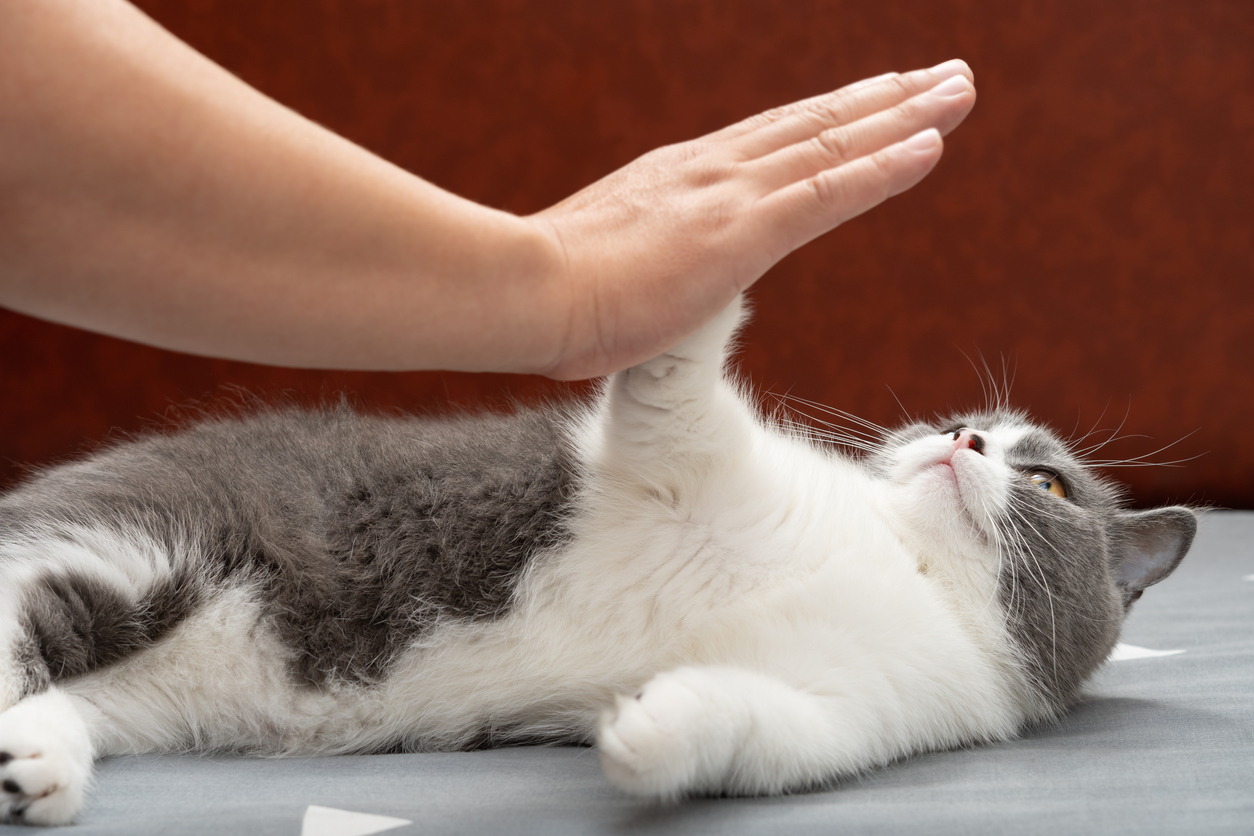








.jpg?height=2000&name=Cliick_Integricare-DISPLAY-REVISEDV2%20(1).jpg)
